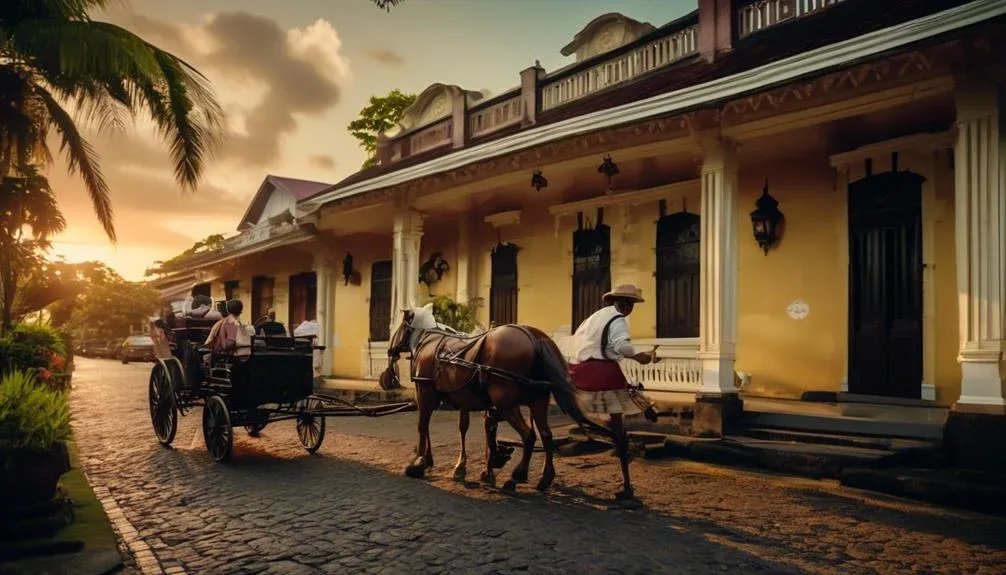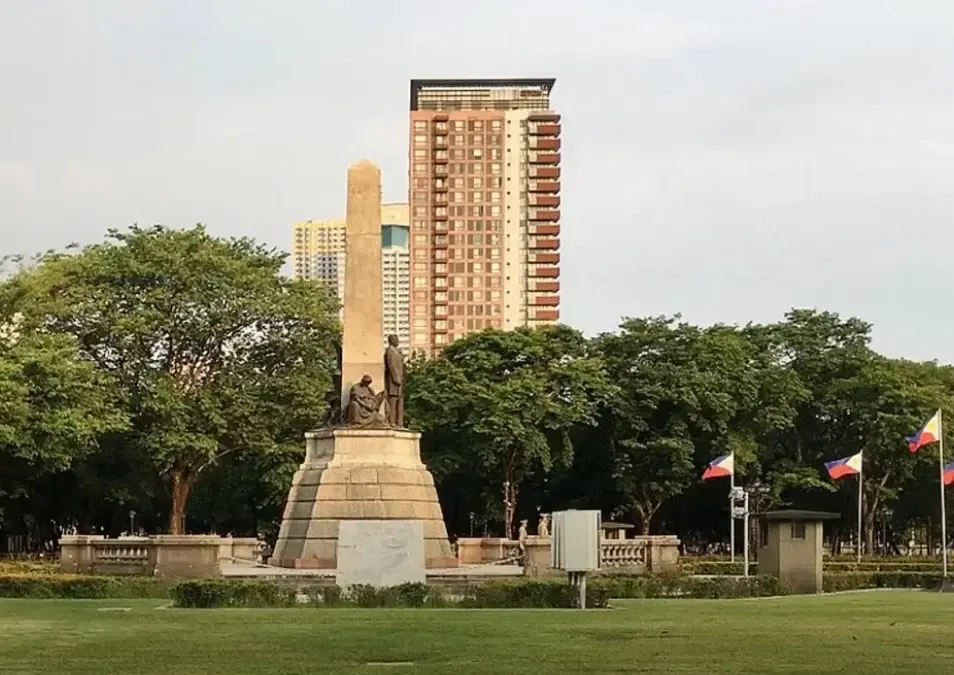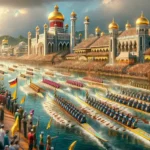Isn’t it interesting how often you find yourself yearning for a deeper connection to the past, only to realize that history is not just found in textbooks, but in the very cities you can explore? As you’ve likely gathered, the Philippines, with its rich tapestry of history and culture, offers more than just breathtaking beaches and mouthwatering cuisine.
It beckons with cities that hold the keys to understanding its colonial legacy, the birth of Christianity in Asia, and the vibrant mix of cultures that have shaped its identity. From the cobblestone streets of Vigan to the historic walls of Intramuros, each city presents a unique chapter in the Philippine narrative.
Before you plan your next adventure, consider immersing yourself in the historical wonders of Manila, Cebu City, Vigan, Baguio, Intramuros, Zamboanga City, and Silay City. What awaits is a journey not just across islands, but through time itself, promising insights and experiences that could redefine your connection to this captivating country.
Key Takeaways
- Manila Cathedral and the National Museum in Manila showcase the resilience and diverse influences that have shaped the city.
- Cebu City offers symbols of Christianization and a celebration of faith and indigenous culture through Magellan’s Cross and the Sinulog Festival.
- Vigan is a well-preserved Spanish colonial town with cobblestone streets, authentic cuisine, and pottery traditions that showcase its enduring legacy of Spanish colonialism.
- Baguio combines American colonial history with natural beauty, including pine forests and Burnham Park, representing the blend of history, culture, and natural beauty in the city.
- Intramuros is a testimony to the complex history of the Philippines, with Fort Santiago, ancient walls, historic churches, and living museums and galleries showcasing the Spanish, American, and Japanese periods.
Manila: Colonial Legacy
Manila’s colonial legacy, deeply embedded in its architecture and cultural landscape, reveals a complex history of foreign domination and resistance, shaping the city’s identity and heritage. As you wander through Manila, you’re walking through layers of history, where every corner tells a story of struggle and triumph. The Manila Cathedral stands as a cornerstone of this legacy, embodying centuries of religious influence and architectural evolution. It’s not just a place of worship; it’s a symbol of resilience, having been rebuilt multiple times due to natural and man-made calamities.
The National Museum, on the other hand, serves as a custodian of the country’s collective memory. It’s where you’ll find artifacts and artworks that narrate the Filipino people’s journey from colonialism to independence. Each exhibit, from Spanish galleons to indigenous textiles, offers a glimpse into the diverse influences that have shaped the nation.
These landmarks, among others, provide a tangible connection to Manila’s past. They’re not just physical structures but repositories of stories waiting to be discovered. As you delve into Manila’s colonial legacy, you’re not merely a spectator; you’re engaging with the living history that continues to influence the city’s culture and identity.
Cebu City: Christianity’s Cradle
Moving from the colonial architecture and historical narratives of Manila, you’ll find Cebu City, heralded as the cradle of Christianity in the Philippines, offering a unique perspective on the nation’s religious transformation and cultural integration. Unlike other cities, Cebu’s blend of historical landmarks and religious festivities offers a profound insight into how Christianity took root in the country.
At the heart of Cebu’s historical significance is Magellan’s Cross, a symbol of the nation’s Christianization. This iconic cross marks where the Portuguese explorer Ferdinand Magellan first introduced Christianity in 1521. It’s not just a relic; it’s a testament to a pivotal moment in Philippine history.
The Sinulog Festival, another cornerstone of Cebu’s cultural heritage, is an annual celebration that honours the Santo Niño (Holy Child). It’s a vibrant mix of religious solemnity, cultural performances, and street parades, showcasing the seamless integration of pre-colonial beliefs with Christian traditions.
To better grasp Cebu City’s historical and cultural landscape, consider these key points:
| Landmark/Event | Significance |
|---|---|
| Magellan’s Cross | Symbol of the Philippines’ Christianization |
| Sinulog Festival | Celebration of Christian faith and indigenous culture |
| Basilica del Santo Niño | Oldest Roman Catholic church in the Philippines, housing the revered Santo Niño statue |
| Fort San Pedro | Oldest and smallest fort in the Philippines, symbolizing Spanish military architecture |
Cebu City stands as a vibrant testament to the resilience and adaptability of Filipino faith and culture.
Vigan: Spanish Heritage Alive
Stepping into Vigan, you’re transported back in time to a well-preserved example of a Spanish colonial town in the Philippines, showcasing a unique blend of local and colonial history. Its cobblestone streets and meticulously preserved architecture offer a vivid snapshot of life during the Spanish colonial era, making it an invaluable site for understanding the Philippines’ complex past.
Vigan’s cultural landscape is deeply intertwined with Ilocano cuisine, a testament to the region’s rich agricultural heritage and culinary ingenuity. Dishes like empanadas and bagnets reflect a fusion of indigenous and Spanish influences, offering a taste of history that is both authentic and deeply rooted in the local tradition. Moreover, Vigan’s pottery traditions, notably the burnay jars, underscore the town’s commitment to preserving artisanal crafts. These earthenware pieces, made using pre-colonial techniques, are not just functional; they’re emblematic of Vigan’s resilience and its inhabitants’ dedication to keeping their cultural heritage alive.
Analyzing Vigan in this light, it’s clear that the city is more than a historical relic. It’s a living museum where the past converges with the present, inviting visitors to explore and appreciate the enduring legacy of Spanish colonialism in the Philippines.
Baguio: American Colonial Charm
Nestled in the Cordillera Central mountains, Baguio stands as a testament to American colonial influence in the Philippines, offering a unique blend of history, culture, and natural beauty. As you explore this city, you’ll be captivated by its pine forests, which not only contribute to Baguio’s fresh air but also serve as a living reminder of its status as the Summer Capital of the Philippines. This title was bestowed upon Baguio due to its cooler climate, a stark contrast to the tropical heat found in the rest of the country.
Here’s a closer look at what makes Baguio a must-visit for history buffs:
| Feature | Description | Historical Significance |
|---|---|---|
| Pine Forests | Expansive forests surrounding Baguio. | Symbolize the American effort to create a hill station reminiscent of those found in their homeland. |
| Burnham Park | A central park named after American planner Daniel Burnham. | Embodies the American colonial vision for Baguio as a well-planned urban retreat. |
| Session Road | The main thoroughfare is lined with shops and cafes. | Represents the commercial growth during the American era, maintaining its original layout and charm. |
Baguio’s blend of natural beauty, American colonial architecture, and vibrant cultural scene makes it an enriching destination for anyone looking to delve into the Philippines’ multifaceted history.
Intramuros: The Walled City
As you wander through the historic streets of Intramuros, you’ll find yourself encased within the ancient walls that have withstood the test of time, offering a vivid glimpse into the Spanish colonial era in the Philippines.
In the heart of Intramuros lies Fort Santiago, a citadel used by the Spanish military that encapsulates the history of the Spanish, American, and Japanese periods in the Philippines. It’s a testament to the complex defence strategies employed during its time. Here’s what makes Intramuros an essential visit for history buffs:
- Fort Santiago: Discover where national hero José Rizal was detained before his execution, alongside intricate military defence structures.
- Ancient Walls: These have been pivotal in protecting the city from invaders, demonstrating advanced Spanish military architecture and strategy.
- Historic Churches: Explore the San Agustin Church and Manila Cathedral, both of which highlight the religious fervour and architectural ingenuity during the Spanish period.
- Living Museums and Galleries: Intramuros is dotted with museums and galleries that offer insights into the rich cultural and historical heritage of the Philippines.
Each step in Intramuros is a step back in time, where the defense strategies and historical significance of Fort Santiago and its surroundings come to life, making it a must-visit for anyone fascinated by history and culture.
Zamboanga City: Cultural Melting Pot
While Intramuros offers a journey through the Spanish colonial era, Zamboanga City, known as Asia’s Latin City, presents a unique blend of cultures that have converged and flourished over centuries.
As you delve deeper into the city’s history, you’ll find that its identity is deeply intertwined with the Chavacano language, a Spanish-based creole that stands as a living testament to the city’s multicultural heritage. This language isn’t just a means of communication; it’s a symbol of the city’s rich past, embodying influences from Spanish colonizers, local tribes, and even traders from the nearby islands and beyond.
At the heart of Zamboanga’s historical tapestry is Fort Pilar. This 17th-century fortress isn’t just a military relic; it’s a cultural beacon that has witnessed the city’s transformation over the years. Originally built to ward off invaders, Fort Pilar now serves as a museum and a shrine, encapsulating the city’s resilience and its role as a crossroads of different cultures.
As you explore its ancient walls, you’re not just walking through a historical site; you’re stepping into a story that weaves together elements of Spanish, indigenous, and Asian influences, showcasing Zamboanga City’s unique place in the Philippines’ cultural mosaic.
Silay City: Negros’ Paris

As you explore Silay City, dubbed Negros’ Paris, you’ll find its rich architectural heritage sites to be a testament to its historical and cultural significance. These structures not only showcase exquisite colonial-era design but also narrate the city’s vibrant past and the lifestyle of its inhabitants during that period.
The cultural festivals, on the other hand, offer a deep insight into Silay’s traditions and arts, reflecting a community that cherishes its heritage while embracing modernity.
Architectural Heritage Sites
Nestled in the heart of Negros, Silay City is renowned for its well-preserved architectural heritage sites, earning it the nickname ‘Paris of Negros.’ Its landscape is dotted with structures that stand as testaments to the city’s rich history, marrying Spanish colonial designs with modern influences. Restoration efforts have been pivotal in maintaining the city’s architectural integrity, allowing visitors to step back in time.
- Ancestral Houses: Showcasing intricate wooden designs and vintage furnishings.
- Public Buildings: Reflecting the Spanish influence with their grand facades.
- Churches: Combining religious significance with architectural beauty.
- Cultural Centers: Modern influences blending with historical narratives.
Silay City’s commitment to preserving its architectural heritage sites not only honors its past but also provides a tangible connection to its history for future generations.
Cultural Festivals Overview
Beyond its architectural marvels, Silay City invites you to immerse yourself in its vibrant cultural festivals, where history and tradition come alive in a spectacle of color and community spirit. At the heart of these festivities are the indigenous celebrations, deeply rooted in the city’s heritage and reflective of its rich cultural tapestry.
These events showcase traditional dances, music, and rituals that have been passed down through generations, offering a window into the soul of Silay. Alongside these cultural displays, the culinary traditions of the region take center stage, with festivals often featuring an array of local delicacies that tantalize the taste buds.
These gastronomic delights, prepared with age-old recipes, provide a flavorful journey through Silay’s history, making each festival a comprehensive celebration of the city’s identity.
Frequently Asked Questions
What Are the Safety Measures for Tourists Interested in Exploring Historical Sites in Areas With Security Concerns, Such as Zamboanga City?
When exploring historical sites with security concerns, like Zamboanga City, you should secure travel insurance and have emergency contacts ready. It’s crucial to stay informed, follow local advice, and prioritize your safety above all.
How Can Visitors Contribute to the Preservation of These Historical Cities While Touring?
You can contribute to the preservation of historical cities by practicing eco-friendly travel, like minimizing waste and carbon footprint. Also, participating in volunteer programs helps maintain these sites, ensuring they remain intact for future generations.
Are There Specific Cultural or Local Etiquette Tips That Tourists Should Be Aware of When Visiting Religious Sites in Cebu City or Mosques in Zamboanga City?
When visiting religious sites in Cebu City or mosques in Zamboanga City, you should wear appropriate religious attire and learn local gestures of respect. Understanding these cultural nuances ensures a respectful and enriching experience.
What Are the Options for Immersive Historical Experiences or Reenactments in Cities Like Vigan and Intramuros for Those Wanting to Delve Deeper Into the Philippine Colonial Era?
You’ll find immersive options like costume rentals for authentic experiences and culinary tours that explore historical flavors in Vigan and Intramuros, offering a deep dive into the Philippine colonial era with engaging, factual, and detailed insights.
Can Tourists Participate in Local Festivals or Events That Celebrate the History and Heritage of These Cities, and if So, What Are Some Examples and How Can They Join?
You can join local festivals celebrating history by checking festival dates and completing event registration. Examples include Vigan’s Binatbatan Festival in May. Detailed, analytical research on each event’s significance provides a deeper understanding of the heritage.
Conclusion
In conclusion, as a history enthusiast, exploring these seven cities will offer you a rich tapestry of the Philippines’ multifaceted past. From Manila’s colonial legacy to Cebu’s pivotal role in Christianity, and Vigan’s well-preserved Spanish architecture, each city presents a unique narrative. Baguio’s American colonial charm, Intramuros’ historic walls, Zamboanga’s cultural diversity, and Silay’s elegance echo the country’s complex history. Delving into these destinations, you’ll gain a profound understanding of the Philippines’ historical evolution and cultural diversity.



